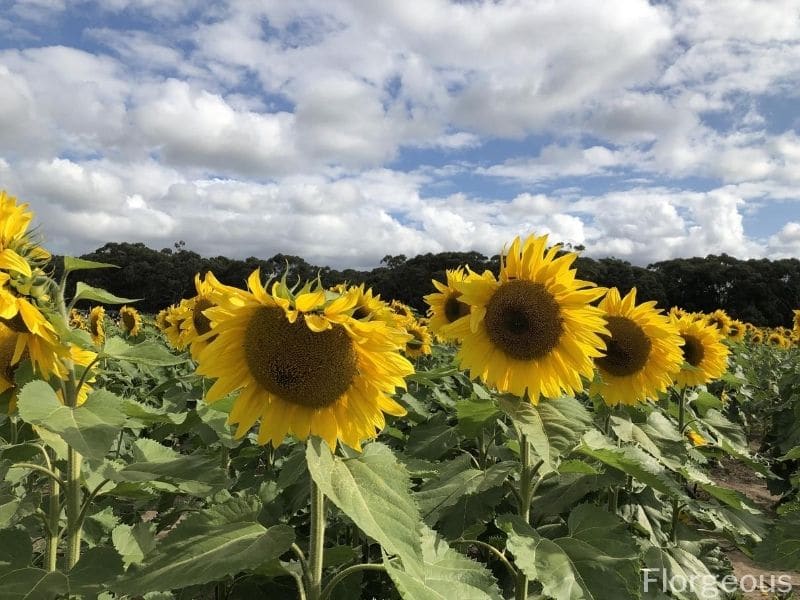We’re all familiar with the idea that certain flowers can symbolize hope. But what exactly do they mean, and why are they chosen to represent this emotion?
For centuries, humans have used flower symbolism to express messages of love, joy, sadness, and more. In fact, it was so common in Victorian times that an entire language developed around it! For example, daisies represent innocence and purity, while roses stand for love and respect.
When it comes to hope-related flower symbolism, there are several options to choose from.
Let’s take a closer look at the flower symbolism of these flowers of hope.
What Flowers that Symbolize Hope and Healing?
If you want to symbolize hope and healing, there are plenty of blooms to choose from. From the prickly pear cactus family flowers to eranthis flowers, there are many flowers that can help you convey the proper message.
Petunias

These vibrant flowers are often thought of as representing hope and healing. The colors of the cup shaped flowers range from deep purples, pinks, and roses to bright yellows and white, offering a spectrum of possibilities for showing off someone’s personality. Petunia blooms are delicate, yet resilient.
Like the people they symbolize, petunias have the potential to bounce back from whatever life throws at them and continue on with their graceful trajectory. Their beauty inspires us to remember that it’s possible for hope and healing in even the most trying of circumstances.
Blue Iris Flowers

Many people associate the iris flower with hope and healing. The soft blue color of this flower conveys a sense of peace and calm, inspiring feelings of renewal and optimism in difficult times. Its versatile and diverse blooms can be seen scattered across meadows in the summer or adding cheerful bursts of color to a garden in winter.
These colorful flowers have a strong symbolism that has been embraced by many cultures over the centuries, making it a great choice for anyone looking to express hope and healing through flowers.
Whether given as a gift or simply as part of an arrangement, this flower of hope is sure to bring some light into any situation.
Cherry Blossom
Cherry trees are the most breathtaking of deciduous trees, each year delighting viewers with their beautiful blossoms that transform landscapes from muted browns and greens to a jubilant flurry of pinks and whites.
Beyond being visually stunning, many have come to associate cherry blooms with hope and healing. Cherry blossom symbolism is often used in art and literature to represent the fleeting beauty of life as well as its short yet powerful potential for renewal.
These blooms stand as an enduring reminder that no matter how hopeless things may seem in the present moment, a brighter future is possible.
You can also grow a cherry tree bonsai in your home for its symbolism.
Amaryllis Flowers

The amaryllis appears in Greek mythology as a symbol for true and undying love. This flower is often associated with strength and determination, being able to survive almost any environment despite its fragility.
For many, simply seeing an amaryllis blossom can fill them with hope during difficult times. Its white blossoms are seen as a sign of new beginnings or the start of a journey towards healing, whereas its bright pink petals symbolize joy and happiness.
Amaryllis flowers are therefore seen by many as a beautiful gift for those in need of hope or looking for potential paths toward emotional healing.
Galanthus

Galanthus, or snowdrop flowers, offer a symbol of hope and healing. The Greek word “Galanthus” translates to “milk-white flower.” These delicate blooms invite healing energy into any space due to their representation of renewal and strength in the face of adversity.
Members of the Amaryllidaceae family, they are commonly found in woodlands but also bring cheer to colder climates when they begin flowering around late winter. Many gardens use Galanthus as something that can be enjoyed in the barest months.
As such, these small but beautiful flowers provide a token of hope and potential for brighter days ahead.
Prickly Pear Flowers
Prickly pear flowers may not be as well-known as other types of blooms, but they definitely deserve more attention!
These small yellow-orange flowers represent strength in times of hardship and difficulty; they also symbolize joyfulness and resilience despite life’s challenges.
Eranthis
This delicate yellow flower is often used to symbolize renewal and optimism.
Also known as Winter Aconite, these flowers are also known for being hardy and persistent, a sentiment shared when providing comfort in times of suffering or loss. The beauty of Winter Aconite represents the strength and fortitude needed to move on from difficult situations.
Each flower comes in different hues, ranging from a deep golden yellow to an almost whitish hue, each providing its own means of expressing hope and giving comfort during trying times.
Red Chrysanthemums

The red chrysanthemum is one of the world’s most recognizable symbols of hope and healing. This chrysanthemum flower has been used for centuries to represent courage and resilience in times of adversity. In Japan, people often give these flowers as gifts during funerals or other occasions where comfort is needed.
Bachelor’s Button
Bachelor’s buttons are cheerful wildflowers with an unmistakable bright blue-purple color. They have long been associated with renewal, optimism, and hope for the future. If you want to show someone your faith in them or wish them well on their journey ahead, a bouquet of bachelor’s buttons is an ideal choice.
Common Poppy

Common poppies are not only beautiful; they are also incredibly symbolic. This flower has come to represent both death and rebirth due to its delicate petals which fade after blooming only briefly. It serves as a reminder that life is fleeting but can be renewed if we take the time to appreciate even the smallest moments we experience along our journey.
What Flowers That Represent Hope and Love?
Which flower represents hope and love? You have plenty of choices. Here are some of the best and most beautiful flowers to represent hope and love, no matter the occasion.
Blue Cornflower
The blue cornflower is a unique and vibrant flower that symbolizes hope, love, and togetherness.
Representing new beginnings, this colorful flower is the perfect gift for friends and family as it expresses a deep emotional connection. Its rich hue evokes a feeling of joy and optimism, which makes it an ideal way to show genuine care for someone else in your life.
The cornflower can be found in most gardens due to its hardiness, making it an easy addition to any decor. People have been giving it as a sign of admiration since medieval times and its symbolism remains true today.
Sunflower

Sunflowers are a classic symbol of hope. They are bright yellow petals with a deep center that looks like the sun in bloom. This sunny flower is often given to people going through hard times as a reminder that brighter days lie ahead.
Not only does this cheerful flower signify hope for the future but it also represents loyalty and adoration for the recipient; think of it as an act of gratitude for their strength in tough times!
Tulips

Tulips are another popular flower known for representing hope, faithfulness, and friendship. These flowers come in various shades ranging from pastel pinks to vibrant purples – making them perfect for any occasion!
The tulip’s petals gently curve up like arms open wide to welcome new friends or celebrate existing relationships. When giving tulips as a gift (or receiving them) you will be reminded of the never-ending promise of friendship between two people.
Daffodils

Like sunflowers and tulips before them, these delicate flowers also represent hope – specifically when it comes to finding love! Daffodils have been associated with love since ancient times; even today sending someone a bouquet of daffodils is seen as an act of unconditional love towards one another.
Did you know that daffodil is also a flower that means loneliness.
Forget Me Not

Mouse’s ear, also known as forget me not, is a flower that symbolizes hope and love.
The Mouse’s ear flower came about due to Greek mythology. The name “Myosotis” comes from the Greek word “mouse’s ear,” which is what the leaves look like. According to Greek folklore, a knight and his lady were walking along a river. He picked up a bouquet of these plants for her, but due to his heavy armor, lost his balance and fell into the river. He cried “forget me not” as he died.
When To Give a Flower of Hope to Someone?
No matter which flower you choose to represent hope in your life, the important thing is that you understand the power it holds. Having hope is essential for surviving difficult times—it gives us strength when we need it most and helps us keep going when all else seems impossible. It’s also a reminder that brighter days are ahead—that no matter how dark things seem right now, we will eventually emerge from this darkness into the light.
Hope is an incredibly powerful emotion that can help us stay strong during difficult times.
While each individual may have their own unique way of expressing this emotion through flowers, there are some common symbols that are universally accepted as representing hope—including daffodils, tulips, sunflowers and more!
No matter which one you choose to express your own feelings of optimism, remember that its power will never be diminished. With enough faith in yourself and your ability to see things through tough times by holding onto your sense of hope—you can overcome anything!
See more:







